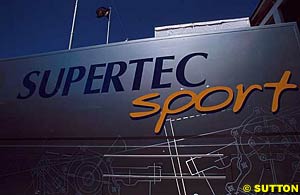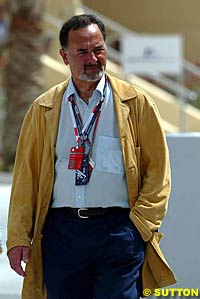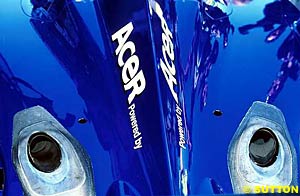Atlas F1 Magazine Writer
Fresh from the Formula One paddock
In the wake of Ford's announced withdrawal from Formula One it is perhaps inevitable that some pretty creative rumours would surround the fates of those entities most affected, Jaguar Racing and Cosworth Racing.
But, one of the more fanciful of the tales suggests that Bernie Ecclestone, possibly in conjunction with Renault F1 boss man Flavio Briatore, would purchase Cosworth and, thus, control Formula One via a stranglehold on engines. This would be in line, implied the rumour's proponents, with Ecclestone's purchase in the eighties of all Cosworth's 3.0 litre engines when F1 went the 1,500cc turbo route, thus saving Cosworth by creating F3000.
Formula One's commercial rights holder, of course, did no such thing – what he did do was to persuade FISA, then the controlling body of motorsport, to implement the 3,0 litre category to replace a dead-on-its-feet 2,0l Formula Two, thereby creating a ready market for the stash of Cosworth DFVs Ecclestone and his FOCA colleagues had accumulated. A subtle difference, maybe, but a very real one when analysing probabilities.
Of course, Briatore will be seeking a career readjustment come his self-confessed departure from Renault at end-2005, but the flamboyant 54-year old businessman enjoys life outside of F1 and could look to pastures new whilst retaining links with the sport via the new GP2 championship, in which he is believed to hold an interest, and through managing the career of protege Fernando Alonso.
What the rumours fail to address, though, is just why Ecclestone and Briatore would purchase what would fundamentally be a liability, for any purchaser would need to indemnify seller Ford from redundancy claims for the period required by EU law – a full two years. And, given that Cosworth Racing employs 600 staff, most of whom are highly-qualified and -paid, significant sureties would be required by Ford to cover possible layoffs. And, why should Ecclestone and Briatore indemnify one of the GPWC initiators?
Neither can Cosworth easily be spun off into separate business units, each supplying various motorsport categories, for Ford would require such asset strippers to furnish the required redundancy guarantees, plus Cosworth's foundries, CNC machines and suchlike cannot function efficiently when split in threes or fours. Equally, just how could such divisions have secure futures when CART is in dire straits; IRL entry lists are shortening; Ford has not yet committed to the WRC, in fact, has announced a possible cut-back and put one current driver on notice whilst not taking up an option on the other; and the futures of Jaguar Racing, Jordan and Minardi are far from certain?
In addition, Formula One's future includes changes to engine formats, from 3.0 litre V10 to a regulatory 2400cc V8, despite existing suppliers BMW and Mercedes suggesting the latter could be costlier in the long run than maintaining the present configuration. Plus, if long life engines are intended to save money, they will, of necessity, reduce profits if their suppliers are commercially driven.
All of which points to Cosworth's salvation as a competition engine supplier lying in a multinational operation purchasing the entire operation with a view to maintaining its existing structure and modus operandi. That entity need not be a motor manufacturer; it would, though, need be a company with requirements to prove its technology on the public stage, in competition. Vickers, previous owner of Cosworth, and vendor of Cosworth Group to Volkswagen/Audi, was one such organisation, but, at the time of sale in the 90s, there were no other prospects. Why some would now surface, when the futures of F1, CART, IRL and WRC are less certain than before, beggars reason.
Honda has been linked with the purchase of Cosworth Racing; again, various questions apply. What performance advantages could it gain, particularly as its own engines have humbled Cosworth's in F1, F2 and F3000 (as Mugen) since the early eighties? Plus, Honda has never shown interest in WRC, and, when in CART or IRL, has done so via in-house technology. Plus, Honda's thin-wall engine casting technology is the equal of Cosworth's expertise, so no advantages there, either.
Volkswagen Audi Group, regularly linked to F1, though, could purchase Racing and incorporate it into Technolgies, thus returning Cosworth to its Vickers structure, but, again, why should it? VAG has proven successful in sports car racing using its Audi and Bentley brands, and has no use for turbocharged, Ford-based rally engines or soon-to-expire F1 units. Equally, IRL and CART have never been on its radars, particularly as Indycar, the predecessor to both championships, severely compromised Volkswagen's close associate Porsche through sudden, costly and punitive rule changes.
In addition, VW is presently locked in bitter disputes with German trade union IG Metall concerning ten-year plans and German job 'exports' of, so discussing lay-offs and motorsport acquisitions in the same breath would be tantamount to corporate suicide. As Ford discovered when closing Jaguar's Brown Lane plant, redundancies and simultaneous F1 programmes are not the best bed partners.
GM? Not likely, certainly not for as long as it maintains links with Ferrari via its strategic alliance with Fiat, and, with Maranello having posted a €60m loss for the six months to June, blaming in part the 'growing costs of Formula One', the chances of the General, which has long maintained a no-F1 policy and left the WRC ten years ago, purchasing Cosworth Racing are slim indeed.
So, where to for Cosworth, and, by extension, Jaguar Racing, Jordan and Minardi? More to the point, where to for F1 in 2005. Much has been made of three car teams to satisfy the minimum numbers clause in the Concorde Agreement, but is that a long-term solution? Sure, Paul Stoddart has a selfish suggestion: allow Minardi to continue through 2005 using existing equipment on the basis that the cars are no threat, but that in no way solves the effects of Cosworth's pending demise. And if, as he proposes, Minardi runs ancient ex-Cosworth 'European' lumps, the cars will certainly not make the 107% cut which any change to the qualifying format will incorporate. Equally, Jordan may find solace in Toyota (or Renault) units, but Jaguar's problem would remain.
Maranello has a massive stockpile of engines, all of which are at least the equal of anything else on offer, all supremely powerful, all utterly reliable. Sure, Sauber's re-inked contract would need be satisfied first, but in these periods of single-weekend engines (escalating to two events per unit), demands on Ferrari's resources, even when supplying four teams, would be lower than back in 2001 when it supplied itself, Sauber and Prost with two engines per car per weekend. That meant up to 18 units per race, whereas the 2005 solution would require just eight.
Such a deal would bolster Ferrari's draining coffers whilst saving three teams from extinction – assuming a buyer is found for Jaguar, which is a separate issue – whilst solving F1's immediate engine supply problems. More importantly, it removes the need for three-car teams, with all the financial pressures it would bring to bear upon the next team facing possible extinction, Sauber.
Moreover, no regulations need be changed to facilitate such arrangements, unlike the three-car lottery, whilst the teams would have the kudos of Ferrari power to sell to sponsors. Of course, the likes of BMW, Honda and Mercedes-Benz may not welcome the challenge of up to eight Ferrari-powered cars, so, hopefully they will be incentivised to supply customer teams. First prize, though, would be the lasting salvation of Cosworth and its illustrious history.

 Then, to further justify the rumour's merits, Briatore's former involvement with Supertec Sport, which marketed Mecachrome's ex-Renault engines after the company handed over a stockpile of V10s to its erstwhile supplier when Renault departed F1 for the second time, is cited. True, the Italian did manage Supertec's supplies during 1999/2000, but there is a world of difference between recycling used F1 engines and the outright purchase of an engineering giant supplying IRL, CART, WRC and MotoGP entries with power units in addition to a third of the Grand Prix grid.
Then, to further justify the rumour's merits, Briatore's former involvement with Supertec Sport, which marketed Mecachrome's ex-Renault engines after the company handed over a stockpile of V10s to its erstwhile supplier when Renault departed F1 for the second time, is cited. True, the Italian did manage Supertec's supplies during 1999/2000, but there is a world of difference between recycling used F1 engines and the outright purchase of an engineering giant supplying IRL, CART, WRC and MotoGP entries with power units in addition to a third of the Grand Prix grid.
 Volkswagen, having bought the Group, retained Cosworth Technologies - the manufacturing and production division of Cosworth plc - and far-sightedly spun Cosworth Racing off to Ford, which had been mortified that competition engines badged 'Ford' could in future be built by VW. Of course, this year, General Motors' IRL engines are built by Ford (through Cosworth) on behalf of Chevy, but that is another story.
Volkswagen, having bought the Group, retained Cosworth Technologies - the manufacturing and production division of Cosworth plc - and far-sightedly spun Cosworth Racing off to Ford, which had been mortified that competition engines badged 'Ford' could in future be built by VW. Of course, this year, General Motors' IRL engines are built by Ford (through Cosworth) on behalf of Chevy, but that is another story.
 Should Cosworth fold, there is, though, another solution. Not too long ago there was a yellow engine support truck, bedecked with a familiar prancing stallion, in the paddock. It disappeared when Alain Prost's eponymous outfit collapsed, and had been supplying Ferrari engines badged 'Acer' to the Frenchman's operation.
Should Cosworth fold, there is, though, another solution. Not too long ago there was a yellow engine support truck, bedecked with a familiar prancing stallion, in the paddock. It disappeared when Alain Prost's eponymous outfit collapsed, and had been supplying Ferrari engines badged 'Acer' to the Frenchman's operation.
|
Contact the Author Contact the Editor |
Please Contact Us for permission to republish this or any other material from Atlas F1.
|
Volume 10, Issue 40
Articles
Interview with Giancarlo Fisichella
Sayonara Oli
2004 Japanese GP Preview
2004 Japanese GP Preview
Japanese GP Facts & Stats
Columns
The F1 Trivia Quiz
Bookworm Critique
On the Road
Elsewhere in Racing
The Weekly Grapevine
> Homepage |
